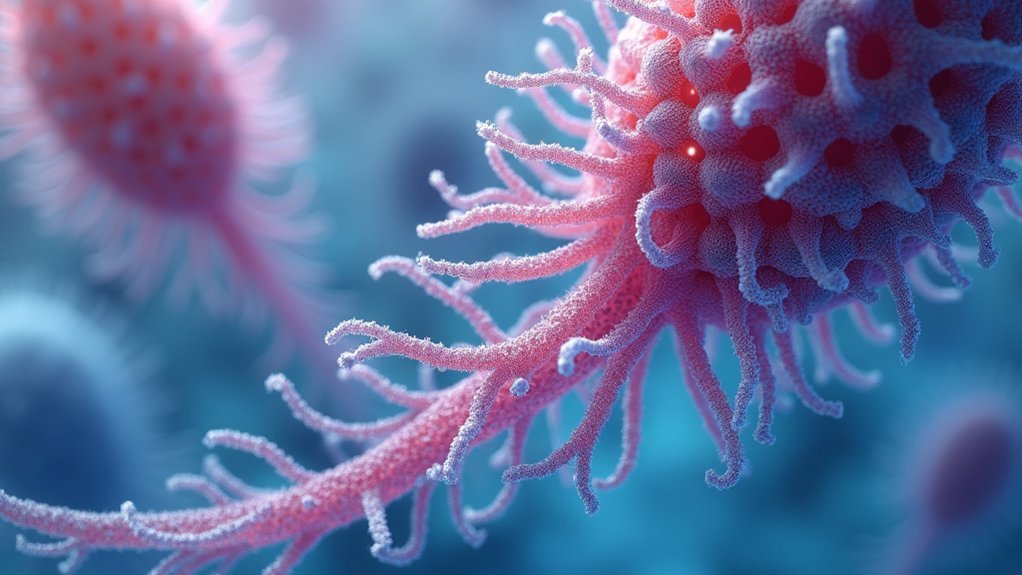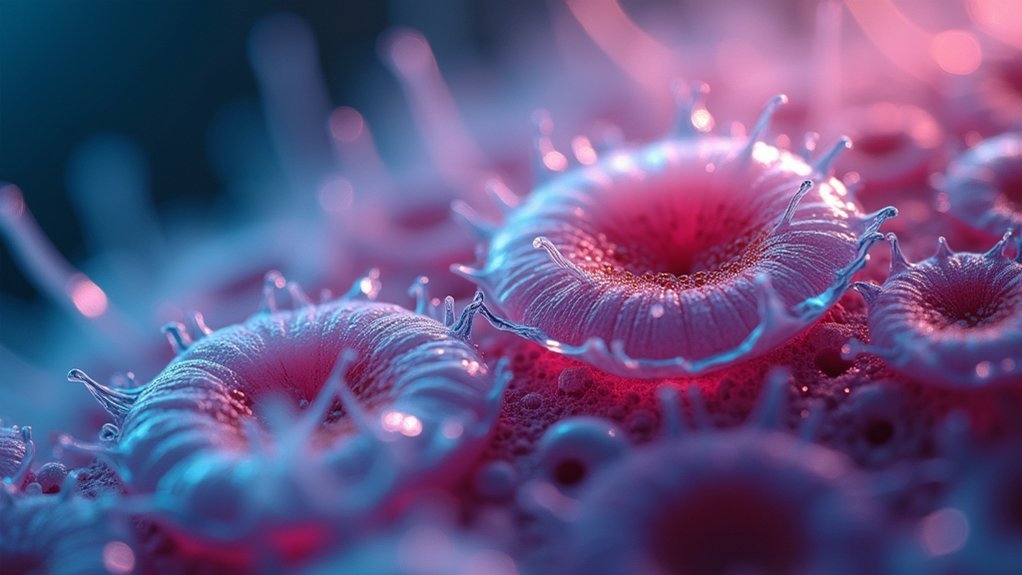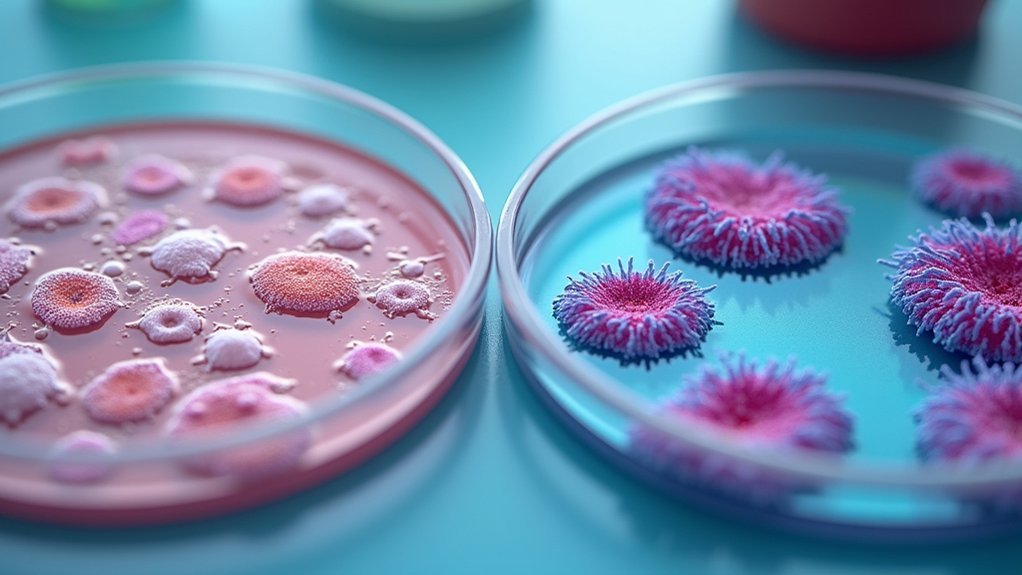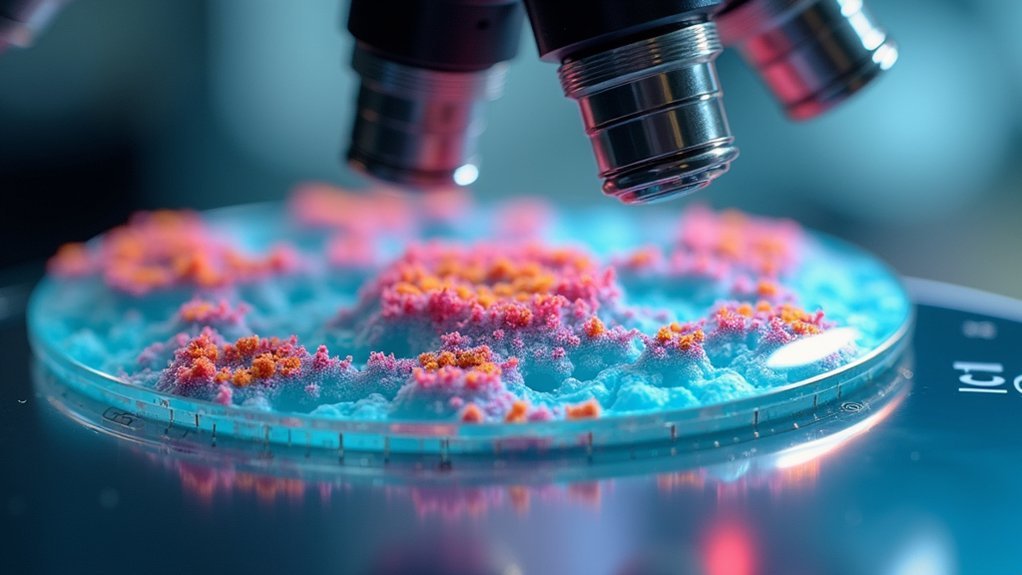Scale bar software matters for scientific images because it transforms your visuals into quantifiable data, preventing misinterpretation. With over half of biology papers lacking proper scale information, using automated tools guarantees accuracy, consistency, and reproducibility in your research. You’ll save significant time through batch processing while maintaining scientific credibility. Proper scale bars enhance image interpretability and strengthen the integrity of your findings. The right implementation methods can dramatically improve how others perceive and validate your work.
Why Scale Bar Software Matters For Scientific Images

Although scientific images appear self-explanatory, they’re often meaningless without proper scale context. Research shows over half of biology papers lack complete scale information, leading to potential misinterpretation.
Without proper markers, you can’t accurately judge the size of structures or features in an image. In clinical settings, the consequences are significant—only 2.61% of dermatology articles include proper scale markers with units, making lesion size assessment nearly impossible.
Scale ambiguity in medical imagery is a dangerous oversight, with critical implications for accurate diagnosis and treatment planning.
Scale bar software like ImageJ/FIJI solves this problem by integrating calibration data directly into your images. These tools allow you to create high-contrast scale bars with standardized units, improving visibility for all readers, including those with color vision deficiencies.
Using automated scale bar creation guarantees your scientific images maintain data integrity while efficiently processing large image volumes.
The Fundamental Role of Scale in Scientific Imagery
Perspective is everything in scientific imagery. Without proper scale information, your microscopic specimens remain abstract visuals rather than quantifiable scientific data. You’re leaving your readers to guess dimensions when over half of published papers fail to include complete scale information.
When you commit to adding scale bars, you transform your images into reliable scientific evidence. Only 2.61% of clinical dermatology images include proper scales with unit marks—don’t let your research fall into this credibility gap.
Tools like ImageJ/FIJI make incorporating precise scaling straightforward. Choose high-contrast colors and simple units to guarantee maximum visibility in your publications.
Common Challenges in Microscope Image Calibration

Despite advances in microscopy technology, accurate calibration remains a persistent stumbling block for many researchers. You might assume your microscope software automatically handles calibration data correctly, but this assumption can lead to serious measurement errors.
Though formats like .tif often store this information, you need to verify its accuracy within tools like Fiji before proceeding.
The consequences of poor calibration are far-reaching—over half of published papers lack complete scale information, undermining scientific credibility. When you use calibration slides, inconsistent measurement techniques can further complicate establishing accurate scale bars.
The misalignment between what’s displayed and actual physical dimensions creates a significant challenge for reproducibility in microscopy-based research. Without proper verification, you risk publishing images that misrepresent the true dimensions of your specimens.
Key Features of Effective Scale Bar Software
When evaluating scale bar software for your scientific images, you’ll want to focus on capabilities that guarantee both accuracy and efficiency. Look for tools that precisely convert pixel dimensions to physical measurements, securing reliable scaling across your research.
Effective software lets you add a scale bar with customizable attributes—adjustable length, color, and font—enhancing visibility in your images. Automation features like batch processing save significant time when handling multiple files simultaneously.
Consider how well the software integrates with popular image analysis programs like ImageJ or FIJI. This compatibility secures seamless calibration workflow and consistent measurement representation.
Finally, prioritize user-friendly interfaces with built-in tutorials. These features help researchers at all technical levels implement proper scale bars, ultimately improving the quality and credibility of published scientific figures.
How Scale Bars Enhance Data Reproducibility

Scale bars serve as the foundation of scientific reproducibility in image-based research. When you include proper scale information in your images, you’re enabling other researchers to accurately interpret and validate your findings.
Studies show that over half of biology papers lack complete scale information, creating significant barriers to reproducibility. Without standardized scale bars, measurement comparisons become inconsistent, leading to potential discrepancies that can fundamentally alter research conclusions.
This is particularly critical in microscopy, where size interpretation directly impacts results. By implementing proper scale bars in your clinical and research imaging, you’re supporting systematic reviews and meta-analyses that depend on accurate data representation.
Your commitment to including scale bars in scientific images establishes credibility and transparency, ultimately strengthening the scientific process through enhanced reproducibility.
Digital Image Calibration Techniques for Accurate Measurement
Before you can add meaningful scale bars to your scientific images, proper calibration is essential to establish an accurate relationship between pixels and real-world measurements.
Using software like Photoshop or Fiji, you’ll need to measure a known distance on a calibration slide to determine the pixel-to-millimeter ratio that guarantees accurate scaling.
- A researcher carefully positioning a micrometer calibration slide under the microscope, with fine markings visible at precise intervals
- The software interface displaying a straight line drawn across the calibration markings, with a measurement dialog box open
- A perfectly scaled scientific image with a crisp, accurate scale bar in the corner, ready for publication
Remember to verify your calibration in the Image Properties section.
Improper calibration can lead to significant measurement errors, while accurate calibration enables reliable scale bars that enhance image interpretability and scientific communication.
Comparing Popular Scale Bar Generation Tools

With calibration properly established, you’ll want to select the right tool for adding scale bars to your images. Several options exist for creating publication-ready scale indicators through efficient Image Processing workflows.
| Software | Key Strengths | Best For |
|---|---|---|
| ImageJ/FIJI | Direct microscope calibration integration | Batch processing scientific images |
| Inkscape | Vector-based, infinitely scalable bars | Publication figures requiring editing |
| Photoshop | Actions and batch automation | Large volume processing |
| Piximetre | Specialized measurement features | Straightforward implementation |
Each tool offers unique advantages depending on your needs. ImageJ excels with microscopy data by preserving calibration information, while Inkscape’s vector approach guarantees your scale bar remains crisp at any resolution. For efficiency with multiple images, Photoshop’s automation capabilities can’t be beat, saving you valuable time in your research workflow.
Best Practices for Scale Bar Placement and Design
Proper implementation of scale bars dramatically improves the interpretability of scientific images while maintaining their aesthetic appeal.
When adding scale indicators to your microscopy images, position them in the lower left corner to preserve space for critical visual data and guarantee visibility against varying backgrounds.
Choose high-contrast colors for your scale bars that won’t blend with image content—avoid red, green, and blue hues that might camouflage against common microscopy stains.
Add scale bars as your final step to accommodate any size adjustments during manuscript preparation.
- A crisp white scale bar against a dark cell membrane clearly communicating 50 μm size
- A thin black bar tucked discreetly in the corner of a tissue section, showing 100 μm dimension
- A yellow scale indicator standing out against blue-stained neurons, providing instant size context
Automated vs. Manual Scale Bar Implementation Methods

Automated scale bar methods offer superior accuracy and consistency compared to manual approaches, which often introduce human calculation errors that compromise data reproducibility.
You’ll find that automation through software like ImageJ greatly reduces the time needed for scale bar implementation—what might take hours manually can be accomplished in minutes with properly configured systems.
Your choice between these methods will directly impact how reliably others can interpret and reproduce your scientific image measurements, making this decision vital for maintaining research integrity.
Accuracy Comparison Analysis
When researchers compare automated and manual methods for implementing scale bars, the differences in accuracy become immediately apparent. You’ll find that automated scale bar software greatly reduces human error while ensuring consistent measurements across multiple images. The software calculates dimensions based on calibrated image data, eliminating subjective interpretation that often occurs with manual methods.
- Imagine reviewing microscopy images with perfectly aligned scale bars that maintain exact proportions regardless of magnification changes.
- Picture your research team producing identical scale representations across different instruments without discrepancies.
- Visualize the time saved when processing hundreds of images with precise scale bars applied in seconds rather than hours.
With automated approaches, you’re not just improving accuracy—you’re standardizing scientific practices across your entire research community.
Time Efficiency Differences
Although both methods achieve the same end result, the time difference between automated and manual scale bar implementation is staggering. When you’re preparing images for publication, automated tools can process hundreds of images in minutes, while manual implementation might take hours of tedious work.
By utilizing specialized scale bar software, you’ll dramatically improve your time efficiency while reducing human error. These tools guarantee consistent placement and accurate measurements across all your images published.
Instead of repetitively adding scale bars to each microscopy image individually, batch processing lets you establish parameters once and apply them universally.
This efficiency isn’t just about convenience—it allows you to redirect valuable time toward data analysis and interpretation rather than spending it on repetitive image editing tasks.
Data Reproducibility Issues
Scientific integrity depends fundamentally on reproducibility, which scale bars directly impact through their accuracy and consistency.
When you manually implement scale bars, you’re introducing potential inconsistencies that undermine the reliability of your research. Studies reveal over 50% of papers lack complete scale information, and only a fraction of clinical images include proper scale references.
Automated scale bar software addresses these reproducibility concerns by:
- Ensuring uniform application across hundreds of images, eliminating the human errors that creep into manual calculations
- Providing precise measurements that remain consistent between researchers and institutions
- Creating standardized visual references that allow other scientists to accurately interpret and build upon your work
Preserving Scale Information in Publication-Ready Figures
When preparing publication-ready figures, you’ll face challenges with digital magnification that can distort scale information if not properly managed.
You must guarantee your scale bars maintain measurement integrity throughout the publication process, as different journals have varying figure size requirements that can affect scale representation.
Your research’s reproducibility depends on preserving accurate scale information, which quality scale bar software can help you achieve by automatically adjusting scale bars when figure dimensions change.
Digital Magnification Challenges
As researchers manipulate digital images through cropping, zooming, or resizing, they often inadvertently compromise critical scale information.
Studies show over 50% of biology papers lack complete scale data, making it impossible to determine actual size relationships. When you digitally magnify without proper scale bars, you’re creating a potentially misleading representation of your specimen.
- A cell structure appears massive on screen when it might be microscopic in reality
- Tissue samples from different magnifications seem comparable when they’re vastly different in scale
- Pathology features lose their diagnostic relevance when presented without size context
Digital tools like ImageJ can help you integrate scale information directly from microscope systems, ensuring your images maintain accurate dimensions regardless of display size or manipulation.
In clinical and research settings, this precision isn’t optional—it’s essential.
Reproducibility Across Journals
Despite the critical importance of scale information, journals across scientific disciplines show alarming inconsistencies in how they preserve and present this data.
Studies reveal that over half of biology papers lack complete scale information, with only 49% of physiology and a mere 28% of plant science publications including accurate dimensions.
You’ll find this problem particularly severe in clinical fields—only 2.61% of dermatology images include proper scales with unit marks, making lesion size assessment nearly impossible.
Without consistent scale bars, you can’t reliably compare results across studies or reproduce findings.
When images are cropped or zoomed without preserving scale information, measurements become meaningless.
To guarantee reproducibility, you should utilize scale bar software that automatically embeds this critical information into your publication-ready figures, enhancing scientific communication and research credibility.
Measurement Integrity Maintenance
Maintaining measurement integrity forms the cornerstone of scientific image publication. When you embed precise scale information directly into your figures, you’re ensuring that readers can correctly interpret your data.
Over half of published biology papers lack complete scale information, compromising their reliability and reproducibility.
Using calibrated images with proper scale bar software allows you to:
- Display dimensions and units consistently in the Infobar, eliminating guesswork for viewers
- Standardize measurements across diverse imaging platforms, preventing interpretation errors
- Create publication-ready figures that adhere to best practices in scientific publishing
Vector-Based Approaches to Scale Bar Creation
While raster graphics lose quality when scaled, vector-based approaches offer superior flexibility for creating scientific scale bars. Unlike pixel-based formats, vector graphics are mathematically defined, allowing you to resize scale bars infinitely without degrading quality or precision.
When you use software like Inkscape, you’ll maintain crisp, clear scale bars regardless of final output dimensions. Add your scale bars after importing images to preserve the original data integrity. For proper calibration, convert pixel measurements to physical units like millimeters.
Vector-based scale bars give you complete control over attributes—adjust size, position, and color with ease as your publication needs change. This adaptability guarantees your scientific images maintain accurate spatial reference while meeting the highest quality standards for journals and presentations.
Frequently Asked Questions
How Is a Scale Bar Used in Scientific Images?
Scale bars in scientific images provide a visual reference for size, helping you interpret the actual dimensions of microscopic features. They’re essential for accurate measurement and comparison of specimens in your research.
Why Are Scale Bars Important?
Scale bars are important because they let you accurately interpret specimen sizes in scientific images. They’re essential for data credibility, enable reliable comparisons, and enhance your ability to validate research findings across different studies.
Why Is a Scale Bar Important in a Microscope Drawing?
In a microscope drawing, you’ll need a scale bar to accurately represent specimen size. It helps you communicate scientific findings, enable comparison between images, and prevent misinterpretation of your research data.
What Are the Rules for Scale Bars?
Scale bars must be accurate, high-contrast, and positioned in the lower left corner of your images. You’ll want to use simple units (like μm), avoid red/green/blue colors, and add them last before publication.
In Summary
You’ve now seen why proper scale bar software is essential to your scientific imaging workflow. By implementing these tools correctly, you’re ensuring reproducibility and clarity in your research. Whether you choose automated or manual methods, you’ll benefit from consistent, accurate scaling across all your images. Don’t underestimate how this seemingly small detail can greatly enhance the integrity and impact of your scientific visual communications.





Leave a Reply